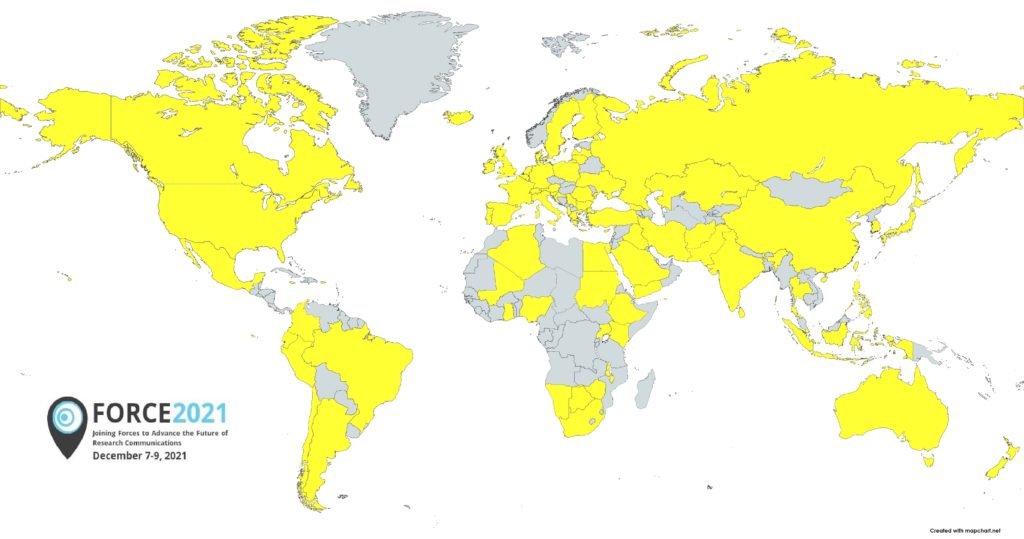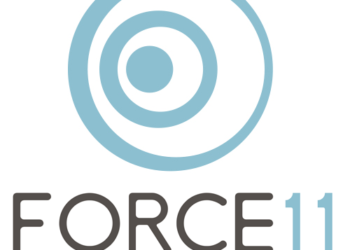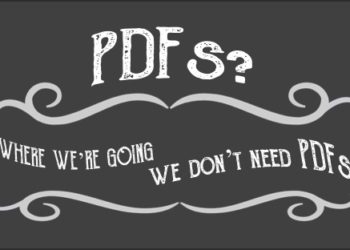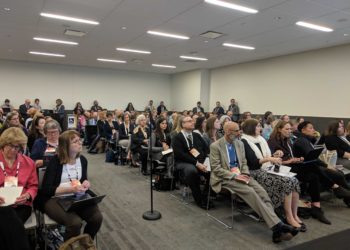FORCE11 has historically drawn one of the more diverse communities in scholarly communication. Participants come from the publishing community and the library community, as well as systems suppliers and most importantly, researchers, with deep engagement from each community. Last week, FORCE11 hosted a second virtual conference since the start of the pandemic and, since moving online, global participation has increased significantly. The conference drew more than 1,300 people from more than 80 countries. The map of participants (shown here) provides a stunning visualization of that.

An international conference doesn’t just happen simply by arranging some speakers and hosting a Zoom meeting. It takes time, it takes effort, it takes planning, and it takes commitment. Over the years, many organizations have made commitments to increasing their international engagement, added it to their goals, and created committees to focus on the issue. Oftentimes, these committees have been comprised of the few members who work internationally, but are either North American or European, but not actually from Asia, Africa, or South America. This isn’t real engagement and doesn’t lead to successful interactions. FORCE11 on the other hand, organized a program committee that brought together members from a dozen countries. These people put together a program that was globally inclusive and therefore engaged people around the world, evidence of which could be seen and heard by all those who participated through the voices and faces that came through Zoom. Even the meeting session schedule was designed to be time-zone friendly for as much of the world as possible (which meant that everyone suffered a little!).
Science has always been an international activity, but often it was hosted under the norms of western European and North American models. Leslie Chan focused on this topic in his opening keynote entitled “Beyond Diversity and Inclusion: Challenging Structural Racism and Systemic Biases in Academic Knowledge Production”. In his talk, Chan described how structural biases are embedded in existing norms and power structures throughout the academy and persist in publishing and research assessment. This opening was followed by a useful community conversation about these topics, which is summarized in this Google discussion document. This topic was revisited in a number of other sessions during the conference. Notably in the “Discoverability in (a) Crisis” session there was an enlightening discussion about how discovery of content impacts people’s impression about scholarly output from non-Western scholars. Presumptions are often been made about the quality of certain research outputs from some areas of the globe, more informed by prejudice than by assessments of an item’s individual quality. Prior to the advent of digital publishing, regional or local scientific publications, perhaps in a non-English journal, might not have wide availability outside of its region of origin, which led to the misperception that such content wasn’t available. This was particularly strking during the Pandemic, in which it was related that a news story conveyed that only two COVID-19 papers were published out of Africa during the pandemic. In reality, the AfricArxiv has hundreds of COVID-related papers, but the reporter simply hadn’t done a robust enough search of the available repositories.
Supporting the inclusivity and global reach was the fact that the conference was free to attendees, with the costs of the conference being borne by sponsors of the event. While I, personally, appreciated the zero-price registration, I’m concerned about the sustainability of that as an approach. Of course, the costs of a virtual event are considerably lower than an in-person event, but the costs are not zero. There are a great deal of hidden costs that are borne by the community, particularly the volunteers on the program committee, that without the support of paid staff can be very challenging. While many organizations have charged significant prices for virtual events, the notion that everything can be done at the same high level consistently without fees seems unrealistic over the long-term.
FORCE11 is also an organization that advances cross-community projects with an aim toward advancing new practices. Several projects also were highlighted during the program, such as work on software citation implementation, which hosted both a deep dive working group update as well as two longer hackathon session before and after the conference, and a newly published recommendation on the Ethics of Research Data Publishing. The software citations implementation group builds on the previous Software Citation Working Group at FORCE11, that developed a set of software citation principles published in 2016. The work on Research Data Publishing Ethics project, which was a joint effort between FORCE11 and the Committee on Publication Ethics (COPE), presented their recently released recommendations. Ideally, this effort will get more attention and repositories hosting data will come to assume the stewardship responsibilities for publishing data in the same way that traditional publishers do for journal articles.
While I certainly miss the in-person days of the FORCE11 meetings, the opportunity to bring together a worldwide audience to discuss how we all can support changing scholarly communications was one not to be missed. In the coming weeks, all of the recorded content from the conference will be made available, so be on the lookout for them. There was a lot of ideas and content, you will want to catch up on, even if you weren’t there live.
Full Disclosure: I serve as a member of the Board of FORCE11.



